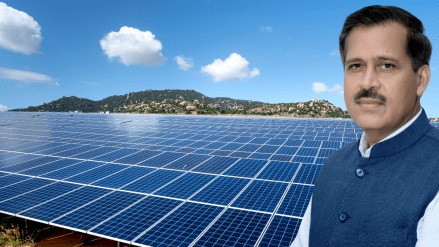By Lokesh Chandra
There is an old saying in Maharashtra… “सूयार्ंिशवाय नसे जीवन धरणीवर, तेव्हा सौरयोजना आहे भिवष्यासाठी वरदान!!” Which means, “Without the Sun, life cannot survive on Earth. Solar energy is thus, the future’s worth!”
We have known this for years, and when the need arose—and in the current context, when the nation is gearing up to become a $5 trillion economy—we, as a nation, must turn to clean sources of energy to attain what has been envisioned.
Today, India stands at a defining juncture in its energy journey. As we transition toward cleaner and more sustainable power sources, a quiet revolution is transforming the rural energy landscape—led by Maharashtra. The state’s pioneering effort to shift 100% of its 16,000 MW agricultural power load to solar energy through the Mukhyamantri Saur Krushi Vahini Yojana 2.0 (MSKVY 2.0) is both visionary and pragmatic.
This initiative, now the world’s largest decentralised renewable energy scheme, goes far beyond conventional policy—it serves as a blueprint for sustainable rural transformation. It is time other states take note.
Decentralised Power, NOT the vision
MSKVY 2.0 is a strategically reimagined version of its predecessor. Designed to provide reliable daytime electricity for agricultural operations, the scheme promotes the development of small, distributed solar projects (2–10 MW) near rural substations—minimising transmission losses and improving power quality.
What sets it apart is its seamless implementation ecosystem:
• Maharashtra Solar Agro Power Limited (MSAPL) as a dedicated nodal agency
• An online land bank portal easing land aggregation
• A single-window clearance system for swift approvals
• Performance-linked incentives and payment security mechanisms to attract credible developers
Multi-layered gains: Economic, ecological and social
The results are compelling:
• ₹68,000 crore in projected investments
• ₹8,000 crore in additional tax revenue
• Over 70,000 jobs—mostly in rural Maharashtra
• 21.78 million tonnes of CO₂ emissions avoided annually
• ₹7,500 crore saved in agricultural subsidies
• ₹9,500 crore in relief from cross-subsidies for industrial power consumers
By improving grid efficiency, cutting carbon emissions, and revitalising the rural economy, MSKVY 2.0 advances multiple Sustainable Development Goals (SDGs) simultaneously.
A scheme that learns and evolves
A hallmark of MSKVY 2.0 is its ability to evolve. The scheme integrates insights from the first phase—introducing mechanisms to mitigate developer risk, streamline approvals, and reward early commissioning.
Through GIS-based land mapping, a digital data room, and transparent bidding frameworks, the program reduces bureaucratic friction and ensures transparency—long-standing challenges in infrastructure rollouts.
Inclusive by design
Beyond technical success, MSKVY 2.0 shines in its inclusive impact. From ₹5 lakh annual grants to host panchayats to boosting women’s participation in agriculture by enabling daytime power access, the scheme fosters community ownership and gender equity.
The creation of a revolving payment security fund sends a strong message to investors about financial discipline and reliability—vital for large-scale private participation.
Why this matters nationally
The PM-KUSUM scheme from the Centre lays the foundation for agrisolarisation. However, Maharashtra’s model shows that the difference lies in execution at the state level. With multi-department coordination, local body involvement, and an enabling environment for developers, MSKVY 2.0 demonstrates what is possible when good policy meets great governance.
If other states emulate this model, the national benefits could be immense:
• Drastic reduction in agricultural subsidies
• Lower industrial tariffs
• Enhanced RPO (Renewable Purchase Obligation) compliance
• Reduced carbon and water footprints
• Boosted rural incomes and employment
Conclusion: A template for Bharat
Energy transition is not just about technology—it’s about leadership and governance. Maharashtra’s example shows that with vision, data-driven planning, and citizen-centric execution, real transformation is achievable.
As India moves towards net-zero emissions and universal access to clean energy, MSKVY 2.0 offers a scalable, replicable, and inclusive model. This isn’t just Maharashtra’s success—it’s Bharat’s opportunity.
Let us not wait for a crisis to catalyse innovation. Let us learn from what works, scale what sustains, and ensure that every unit of energy lights not just homes, but also hopes—for a greener, more resilient India.
The author is a serving Indian Administrative Officer, currently the Chairman and Managing Director of Maharashtra State Electricity Distribution Company Limited.
Disclaimer: Views expressed are personal and do not reflect the official position or policy of FinancialExpress.com. Reproducing this content without permission is prohibited.
